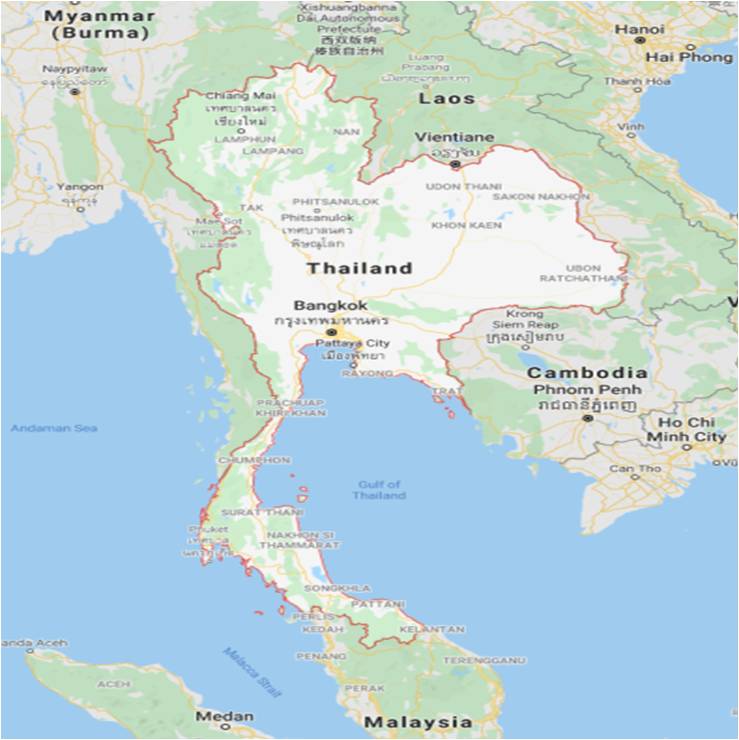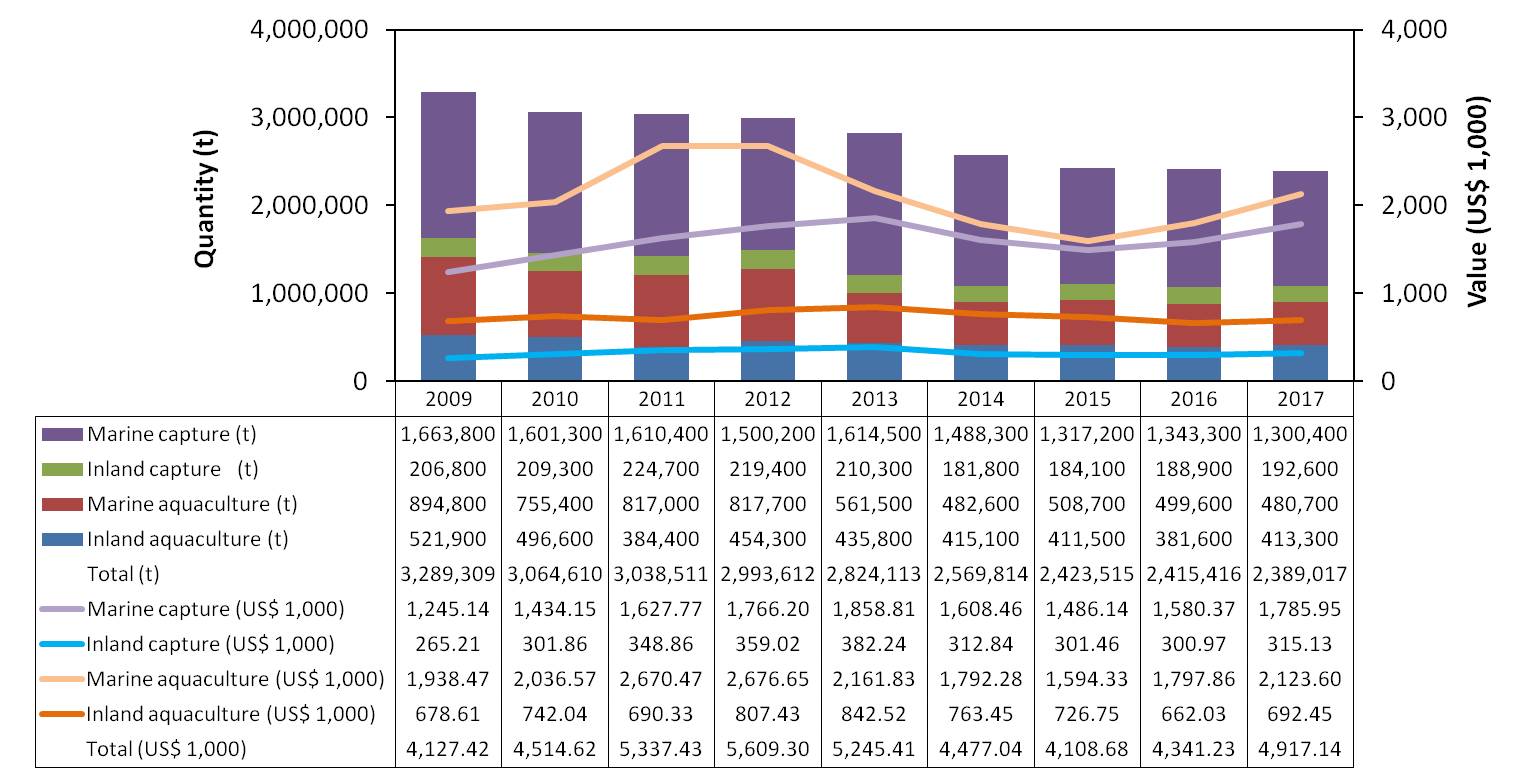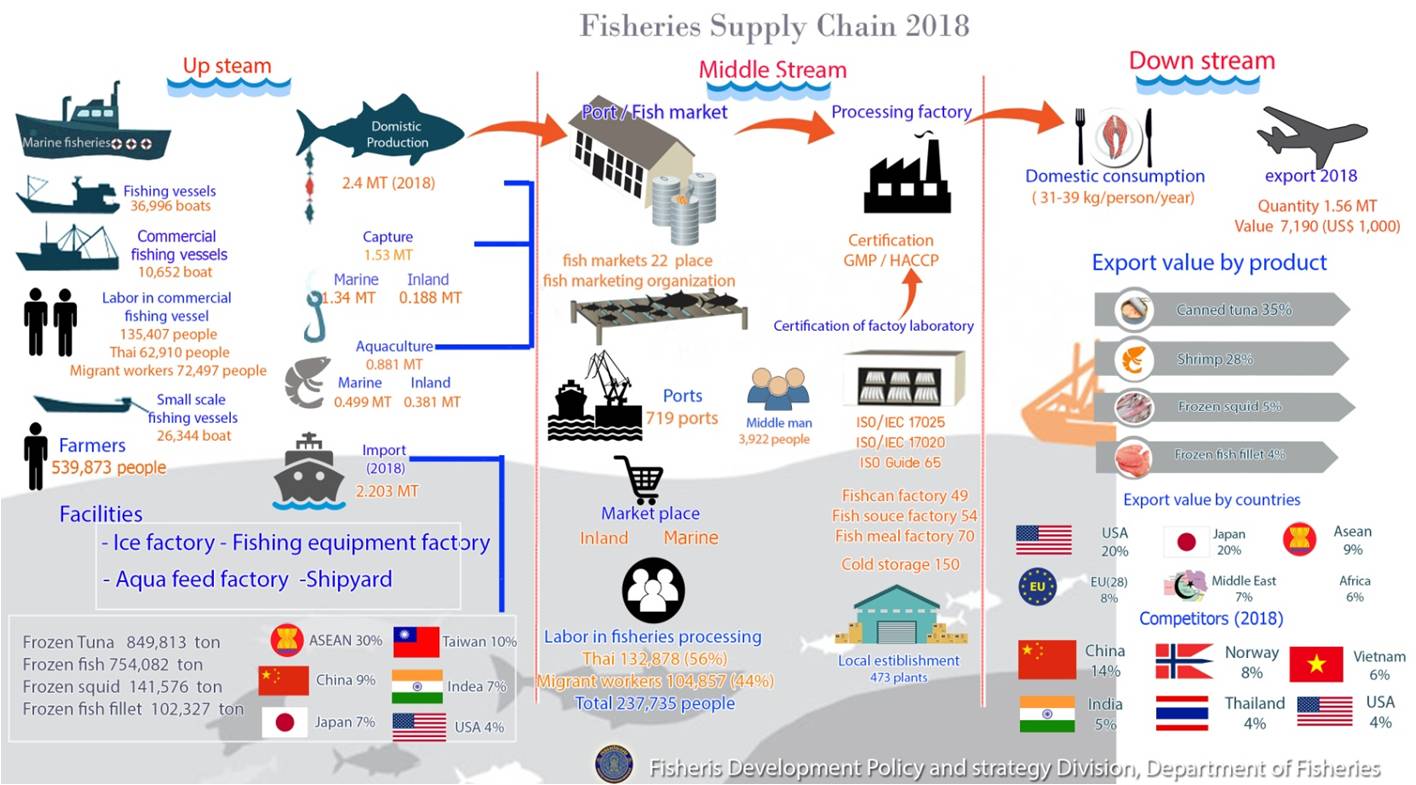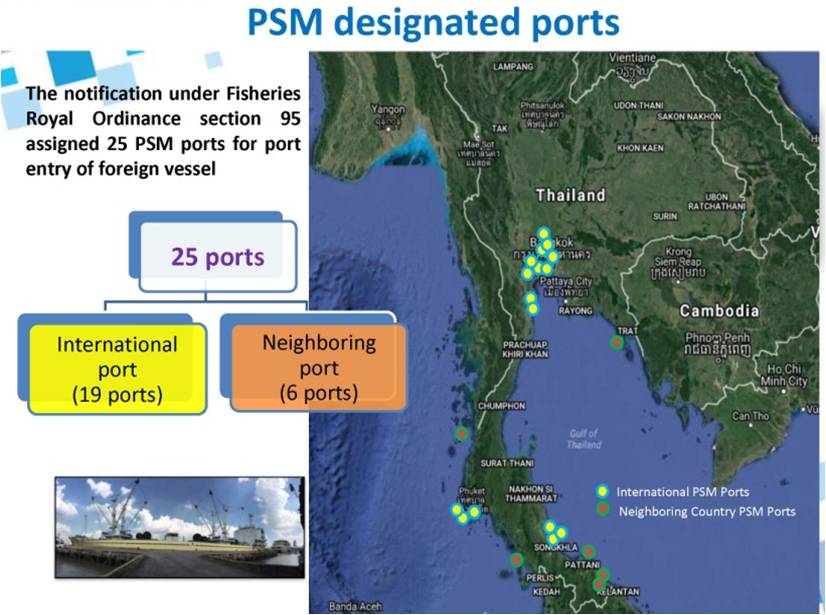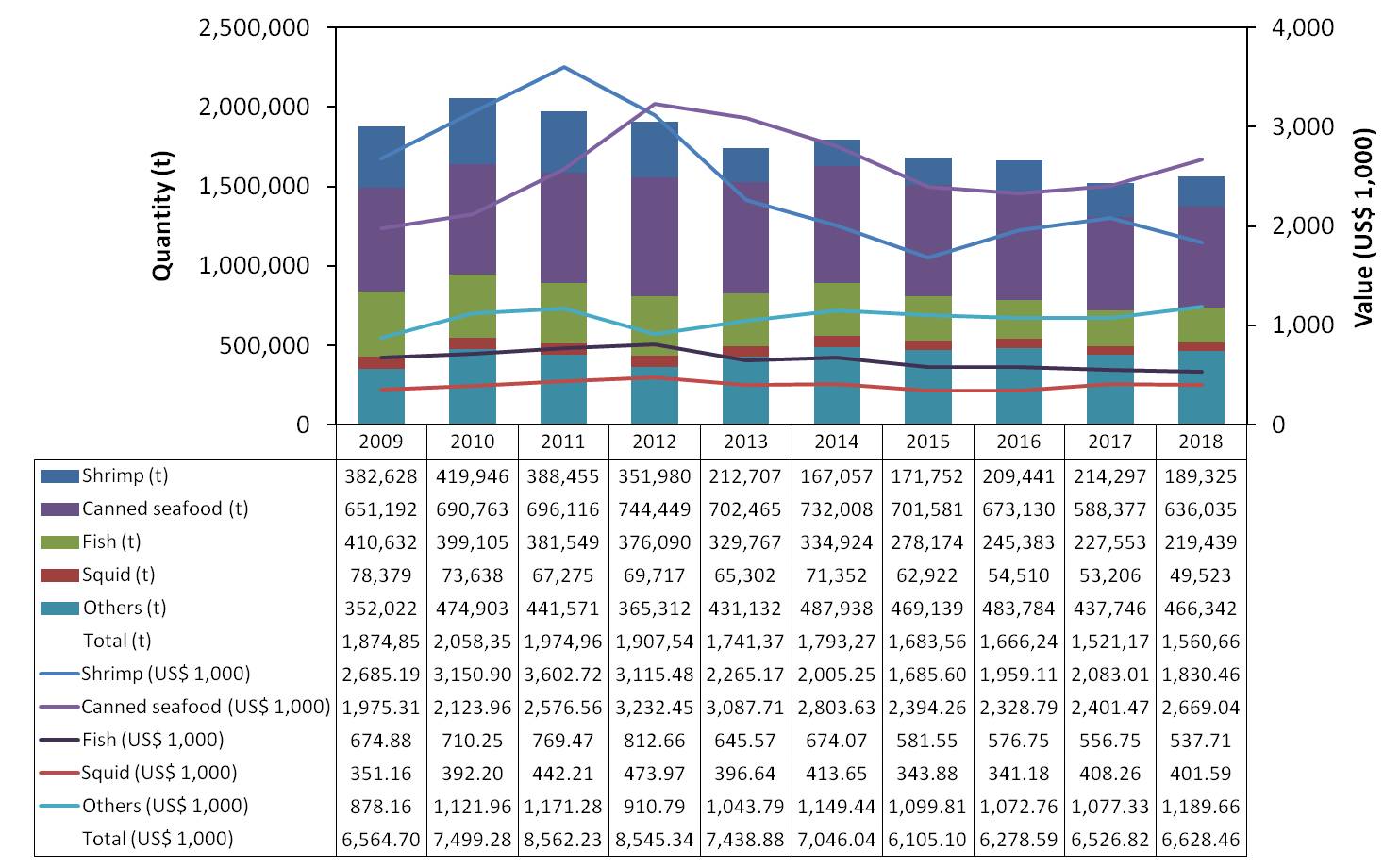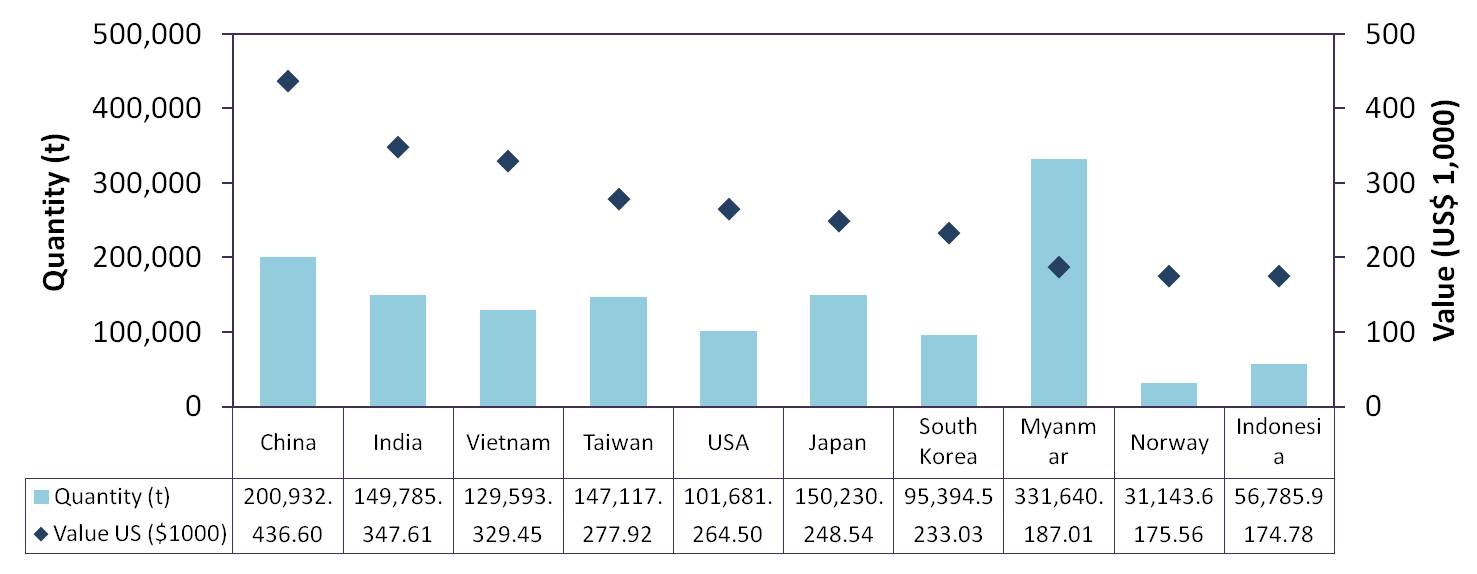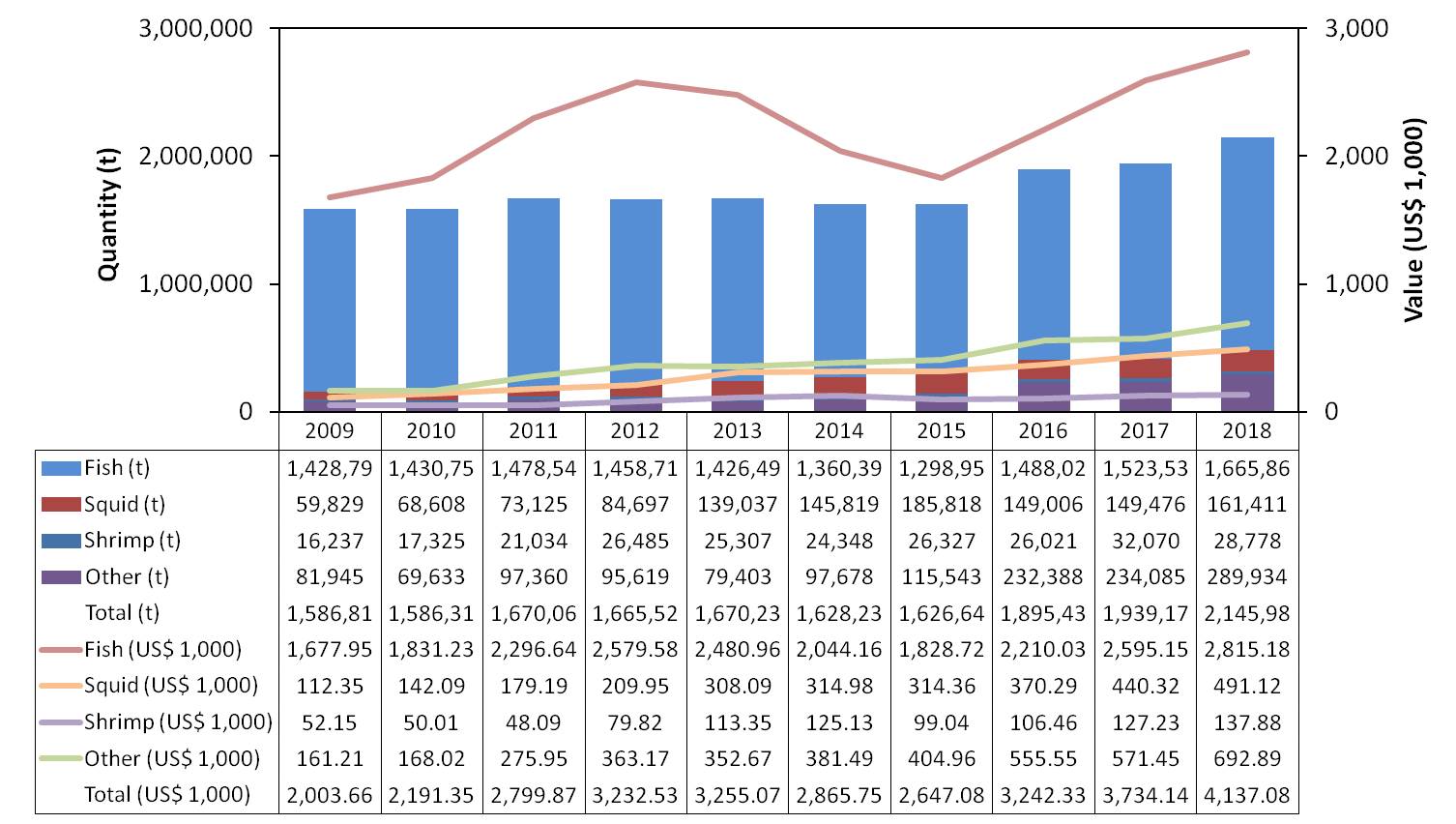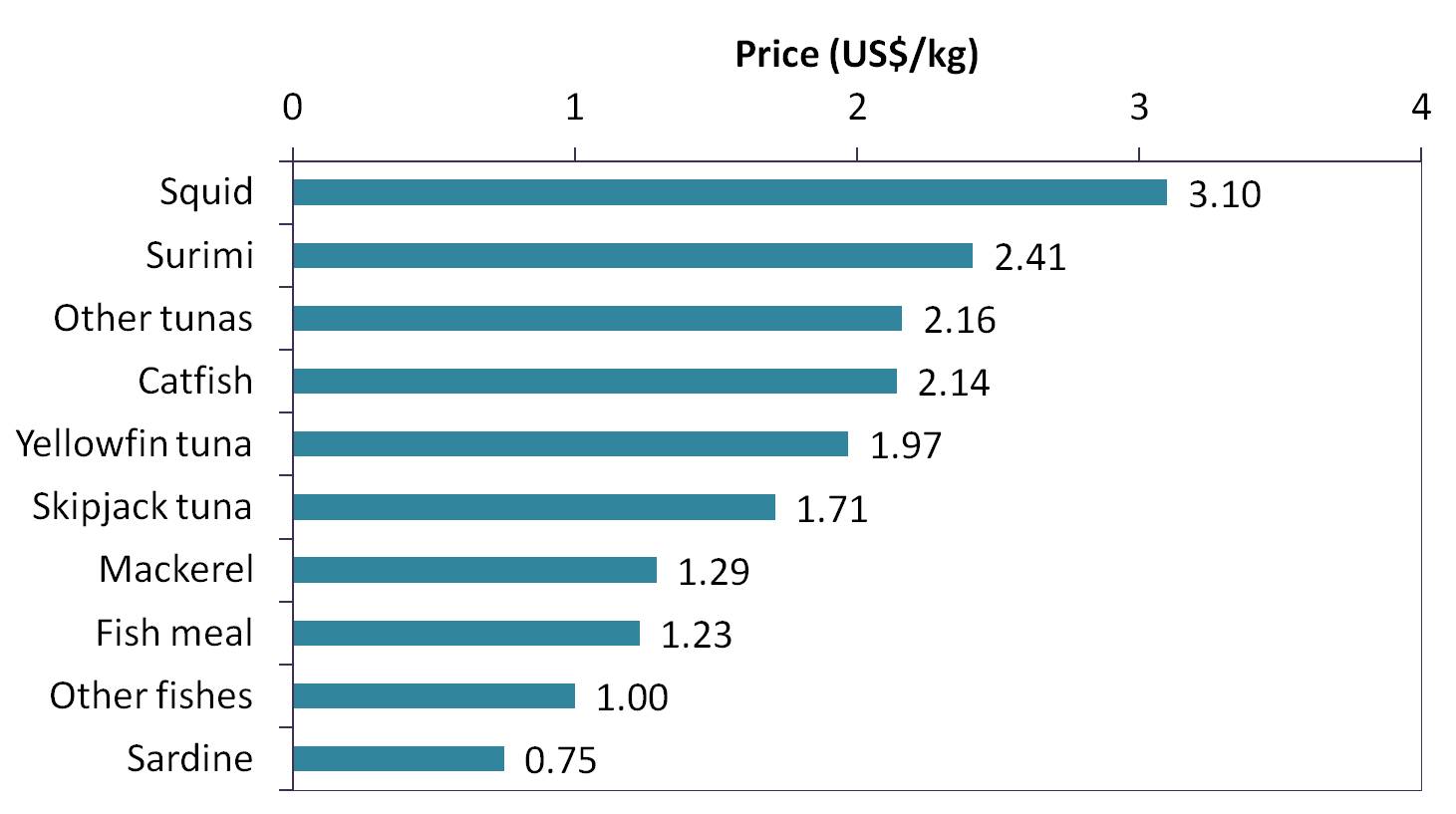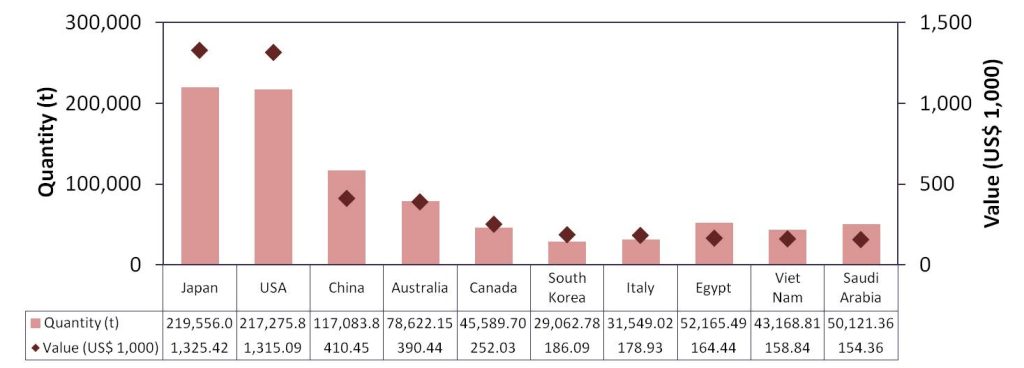By Sumolmal Suwannapoom, Regional Fishery Policy Network for Thailand, 2019
INTRODUCTION
Thailand is a Southeast Asian country located between the Gulf of Thailand in the east and Andaman Sea in the west (Figure 1). The country consists of 77 provinces and its total land area is about 514,000 km². The exclusive economic zone covers an area of about 299,397 km2. It has 25 river basins and 254 sub-basins, and the two principal river systems are the Chao Phraya River and Mekong River. The total area of inland waters is approximately 3,750 km2. In 2018, the country’s population was 66.41 million and the GDP per capita was US$ 7,273.56 and the fisheries GDP was US$ 3,560 million (Thailand, 2019).
FISHERIES SECTOR
Fish is considered as the primary source of animal protein for most of Thailand’s population, particularly those in the coastal provinces. The price of fish is generally low compared to other sources of animal protein and the level of consumption varies because of the differences in household incomes, species preference, and geographic locations. In 2018, the fish consumption was 31-39 kg/capita which were higher than the consumption of other three main sources of animal protein such as pork, beef, and chicken.
The fisheries sector is categorized into capture fisheries (inland and marine) and aquaculture (inland and marine). For inland capture fisheries, most catch are mainly for sustenance and the species include carp, tilapia, and snakehead caught from rivers, canals, irrigation canals, reservoirs, fish ponds, and swamps using hook and line, traps, and gill nets (Choongan, 2018). For marine capture fisheries, the fishing gears are purse seine and trawl and the owners of fishing vessels should have fishing license issued by the Department of Fisheries, Thailand . Furthermore, the aquaculture areas are mostly located in the Central and Northeastern part of Thailand. For inland aquaculture, the culture systems include monoculture, polyculture, and integrated farming with animals. The cultured species include tilapia, catfish, snakeskin gourami, lobster, and snakehead. For marine aquaculture, the cultured species include marine shrimp, sea bass, and grouper. Moreover, the fisheries sector is one of the important sources of income in Thailand. There are over 800,000 laborers in fish farms and related fisheries industries (539,873 in aquaculture, 132,878 in fish processing, and 135,407 in a commercial fishing vessels) (Choongan, 2018).
The fisheries production of Thailand was gradually decreasing during the period 2009-2017 (Figure 2). In 2017, the estimated quantity of fisheries production was 2.39 million t with the value of US$ 4.92 million (DOF, 2019).
FISHERIES TRADE
The fisheries supply chain is composed of three stages, namely: 1) Up stream – production of fish and fishery products from capture and aquaculture, 2) Middle stream – fish and fishery products are transported to ports and fish markets, and 3) Down stream – domestic consumption and export of fish and fishery products (Figure 3). The DOF’s Fish Quarantine and Inspection Division (FQID) is responsible for the management of the operations related to the control, export, and import of aquatic animals and aquatic products. The FIQD coordinates with relevant agencies within the country as well as foreign agencies in order to comply with international laws and agreements (DOF, Department of Fisheries of Thailand).
The Royal Thai Government has established 31 Port-in Port-out (PIPO) Control Centers’ in 22 coastal provinces (Figure 4) for the inspection of aquatic animals upon entry to the port to ensure traceability of aquatic animals and fishery products throughout supply chain. Moreover, the country has designated 25 ports for entry of foreign vessels to comply with the port State measures (PSM) under the Fisheries Royal Ordinance section 95 (Figure 5).
EXPORT OF FISH AND FISHERY PRODUCTS
The main fish and fishery products exported by Thailand are shrimp, canned seafood, fish, and squid. In 2012, even though the volume and value of shrimp started to decline due to low production caused by disease, the volume and value of canned seafood increased (Figure 6). Crab meat was the most expensive product (US$ 30.07/kg) in 2018 (Figure 7) and in terms of value, Japan was the top country of destination of fish and fishery products (Figure 8). The fish and fishery products of Thailand are in good quality which makes it acceptable in the world market and the country is gaining revenue of more than US$ 6.32 billion per year.
IMPORT OF FISH AND FISHERY PRODUCTS
From 2009 to 2018, Thailand imported fish, squid, shrimp, and other fishery products with an average volume of 1.75 million t per year with an average value of US$ 2.97 million per year (Figure 9). Squid had the highest import value at about US$ 3.10/kg in 2018 (Figure 10). In 2018, Myanmar was the top source of imported fish and fishery products in terms of quantity of more than 300 thousand t, however, China had the highest value of about US$ 400 thousand (Figure 11).
ISSUES ON FISHERIES TRADE
The fisheries sector of Thailand is facing the following issues:
- Lack of the ability of fish farmers to negotiate prices with middlemen
- Disease outbreaks in shrimp production which result to price increase
- Low supply of human labor on commercial fishing vessels
- Increasing wage rate of Thai workers which led to hiring of migrant workers with lower salary
- Unresolved labor issues in shrimp industry and commercial fishing vessels
- Inefficient traceability system for importing of raw materials
- Inefficient quality control of raw materials in small fish processing industry
- Slow development of new products with a higher value due to the lack of appropriate production technology
LAWS ON FISHERIES TRADE
Thailand has issued the Royal Ordinance on Fisheries B.E. 2558 (2015) which was updated by the Royal Ordinance on Fisheries No. 2 B.E. 2560 (2017). The following are the chapters related to fisheries trade:
- Chapter 7 Control, Surveillance, Traceability, and Inspection – the provisions of this Chapter aim to achieve effective monitoring, surveillance and control of fishing activities and the implementation of an effective traceability system which enables the identification of the source of an aquatic animal or aquatic animal product at any stage from fishing operations to ultimate consumers.
- Chapter 8 Hygiene Standards of Aquatic Animals or Aquatic Products – Section 98 states that it shall be a duty of the Department of Fisheries to develop hygiene standards related to the catching, caretaking, and processing of aquatic animals, and the storage, transportation or transshipment of aquatic animals and animal products, which are to be promoted among fisheries entrepreneurs so that they apply such standards in their business operations in order to obtain aquatic animals and aquatic animal products that guarantees a quality level with respect to hygiene standards and safety for consumers. The determination of standards pursuant to paragraph one shall be in line with international standards. For the purposes of promoting and encouraging fisheries entrepreneurs to conform to standards pursuant to paragraph one, the Director-General or a person assigned by the Director-General shall issue a certificate to an applicant who has attained such standards as requested.
INTERNATIONAL TRADE AGREEMENTS
The following are the MOUs on fisheries trade between Thailand and other coastal states:
|
Parties |
Objectives |
Date signed |
| Thailand and Sri lanka | – cooperate in the development of fisheries in the two countries by establishing technical and economic cooperation
– trade of fish and fishery products including ornamental fish between Sri Lanka and Thailand |
30 July 2004 |
| Thailand and Viet Nam | – exchange information on the legislation system, its revision, and supplementation concerning the control of fishery quality
– sanitary and aquatic animal diseases throughout the production chain, towards the processing and placing on the market of fish and fishery products thereof, especially the regulations on the control of import-export of fishery products |
7 July 2006 |
| Thailand and Fiji | – technology transfer and trade promotion in the field of fisheries between the Parties, without prejudicing other fields of cooperation that may be considered in the future |
14 December 2015 |
| Thailand and Philippines | – sharing of data or information relating to transshipment and landing of catches for purposes of traceability and catch certification
– fisheries trade and promotions – joint research activities – combating, deterring and eliminating IUU fishing |
4 April 2016 |
| Thailand and South Korea | – promote cooperation between the sides on the economy and technology in the field of fisheries and on the prevention, deterrence, and elimination of IUU fishing |
9 August 2016 |
| Thailand and Myanmar | – strengthen and promote technology and information transfer, trade, training, scientific and technical cooperation and law enforcement in the field of fisheries between the Parties, without prejudicing other fields of cooperation that may be considered in the future |
2 February 2017 |
| Thailand and Lao PDR | – promote academic cooperation
– exchange of information and technology in the development of the fishery sector |
14 September 2017 |
| Thailand and Papua New Guinea | – promotion and encouragement of cooperation in marine fishing techniques, aquaculture, fishery processing, fishery import-export and other industries related to fisheries
– exchange of views and experiences in the implementation of policies, regulations in fisheries, fisheries trade and investment promotion, and market expansion on the basis of mutual benefits in the context of regionalization and globalization |
29 May 2018 |
| Thailand and Cambodia | – strengthen and promote technical and economic cooperation
– executing joint projects and trade promotion in different fields of fisheries between the Parties, without prejudice other fields of cooperation that may be considered in the future |
24 January 2019 |
| Bay of Bengal Initiative for Multi-Sectoral Technical and Economic Cooperation (BIMSTEC) | – costal shipping agreement
– deep sea shipping – trade and investment – transport |
2017 |
WAY FORWARD
Thailand would carry on with implementing the activities to meet the international standards related to fisheries trade such as the good aquaculture practices (GAP), food quality control, good manufacturing practices (GMP), Hazard Analysis and Critical Control Point (HACCP), and International Organization for Standardization (ISO). Also, the country would continue to develop and improve the fish and fishery product standards required by importing countries such as the Marine Stewardship Council (MSC) and the Food Safety Modernization Act (FSMA) of the USA.
Moreover, the government also started to implement the National Strategy projects under Thailand’s Constitution of 2018-2037 including preventing IUU fishing, development of sustainable fisheries and aquaculture systems, maintaining the country’s leading status as processor and exporter of high-value marine products in an environment-friendly and sustainable manner.
REFERENCES
Choongan, C. (2018). Thailand’s Fisheries Situation. Bangkok: Department of Fisheries of Thailand. Bangkok, Thailand.
DOF. (2019a). Fisheries Development Policy and Strategy Division, Department of Fisheries of Thailand. Bangkok, Thailand.
DOF. (2019b). PSM designated ports. Fishing and Fleets Management Division, Department of Fisheries of Thailand. Retrieved from https://www4.fisheries.go.th/local/file_document/20171114131523_1_file.pdf
ACKNOWLEDGMENTS
This article was supported by the Department of Fisheries of Thailand particularly the Fisheries Development Policy and Strategy Division, Fishing and Fleets Management Division, Coastal Aquaculture Research and Development Division, and Fish Quarantine and Inspection Division. The author would like to express gratitude to Mr. Prapan Noradee from the International Fish Trade Analysis Group for providing the fisheries statistical data. Moreover, she would like to thank SEAFDEC for the opportunity to participate as 2019 RFPM Member and learn about fisheries trade. She is grateful to Ms. Pattaratjit Kaewnuratchadasorn and 2019 RFPN Members for their understanding and support in completing this article. Special thanks to Ms. Virgilia T. Sulit and Dr. Shiela Villamor Chumchuen for improving this article.
ABOUT THE AUTHOR
Ms. Sumolmal Suwannapoom is a Fisheries Officer at the Human Resource Recruitment Group, Personnel Division of the Department of Fisheries of Thailand at 50 Lat Yao, Chatuchak, Bangkok 10900 and Tel. +662 562 0600-15. Her Email is sumolmal1979@gmail.com.
 SEAFDEC Southeast Asian Fisheries Development Center
SEAFDEC Southeast Asian Fisheries Development Center
